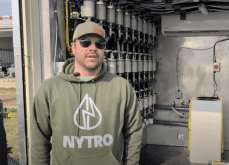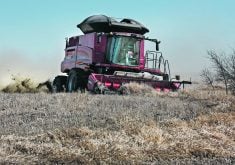EXTRACTING the most heat from a straw bale is no longer a big deal for Raymond Dueck. His Biomass Energy System Technologies device already does that so his new challenge is to extract money from the heat generated by the system.
“There is clearly a lot of energy available in straw. And there are all sorts of ways now to capture it and do something useful with it,” said Dueck.
“Right now, we’re working on several options to take this captured heat and convert it to electricity.”
Read Also

VIDEO: Ag in Motion documentary launches second season
The second season of the the Western Producer’s documentary series about Ag in Motion launched Oct. 8.
The Manitoba entrepreneur said once the biomass generated heat is harnessed, it can be used for anything from running industrial engines to heating urban subdivisions to powering factories.
“The way it works now, the most cost-effective way of using this energy is a commercial setting. It’s relatively inexpensive to install hot-gas to hot-water heat exchangers.”
He said the first two-stage, close-coupled combustor he built is still working well today. It was built for a factory he owned in Arborg 10 years ago.
His second customer was a wood pelleting plant in Estonia. The six million BTU system dries wood chips to be processed into wood pellets for home heating in Europe. It’s a common form of home heat, so the market is big.
At the Estonia facility, the 1,600 C air from the BEST afterburner is blended with fresh outside air to bring the temperature down to 315 C, the safe drying temperature for wood chips. The Estonian company has asked for six more of the units.
Dueck said they don’t run the afterburner heat through a heat exchanger but just blend in the right volume of cool outside air and blow it on the moist wood chips.
His third system was installed last fall in a commercial greenhouse in Saskatoon. This setting is where his system will probably be the most effective.
“The system itself is working very well, but the (computer) controls are the tricky part,” he said.
At head office in St. Adolphe, Man., there is a twin sister to the Saskatoon system expected to be operational when flood waters from the Red River recede from the area.
“When things dry up, we’ll fire it up here and run it through the paces to make sure the new computer is functioning as it should. Then we’ll just remove the computer and bring it out to Saskatoon.”
Dueck said his next step is to find a half dozen businesses within a reasonable driving distance of St. Adolphe that require large amounts of heat. He wants enough facilities there so he can work closely on fine tuning the controls.
It might work for a large capacity grain handling facility, but would be a significant investment, he said.
Dueck is also exploring markets for the silica byproduct.
Silica is an essential element in the metabolism of grassy plants, which explains why it shows up in wheat straw. There’s no lack of silica in the world, so the laws of supply and demand should favour the buyer. However, it is used extensively in electronic components, glass, cements, ceramics and plastics so a market will likely be found.
Dueck recalls that he met with a lot of resistance when he first went looking for funding to help research his burners.
“We were told by a dozen engineers that what we wanted to do cannot be done. It’s been tried in the past and it never worked, so it won’t work for us.”
Dueck approached CanMet, a federal lab in Ottawa that specializes in burning technology, for help researching burners.
The lab offered Dueck a grant for $40,000 and he kicked in $2 million more.
Biomass burning ventures can be attractive to potential investors because the flexibility of the fuel reduces financial risk associated with commodity price fluctuation. Fuel costs relate to biomass availability in the field rather than global grain or petroleum markets.
It also serves a localized need when value-added processing facilities buy locally produced straw to feed the burners, giving farmers and truck operators added income.
For further information visit www.innovaat.com.















